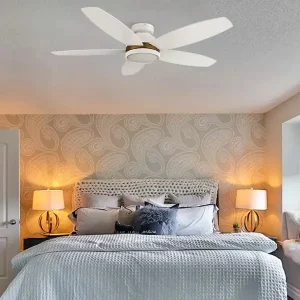Adding a ceiling fan to your home is not only a great way to enhance air circulation but also adds lighting and a touch of style to any room. While the task may seem daunting, with the right tools and some basic knowledge, installing a ceiling fan can be a manageable DIY project. Here’s a straightforward guide to help you set up your new ceiling fan or replace an old one.
Important: Before beginning, refer to your specific ceiling fan’s manual for any unique installation requirements.
Safety First These installations require handling weighty fixtures and electrical wiring. If you’re not confident with electrical tasks, consider hiring a professional. Always have someone to assist you during the process to handle the bulk and complexity of the task.
Step 1: Power Off Ensure your safety by turning off the power to the room at the circuit breaker. Verify the power is completely off with a circuit tester.
Helpful Tip: Labeling your home’s breaker switches with the corresponding rooms can simplify any electrical project.
Step 2: Remove Existing Fixture If replacing a fan or light fixture, first remove any light bulbs and covers. Unscrew the mounting screws and carefully lower the old fixture. Disconnect the fixture’s wiring, keeping the wires separated and safe.
Helpful Tip: Removing a ceiling fan’s blades before the base can make this step easier, especially in tight spaces.
Step 3: Install the Mounting Bracket Check that your ceiling’s electrical box is rated for a ceiling fan—these are typically reinforced due to the fan’s motion and weight. Attach the new fan’s mounting bracket to the electrical box, ensuring it’s securely fastened to a beam or a brace between beams.
Step 4: Assemble the Fan Assemble your new fan according to the manufacturer’s instructions. This usually involves attaching the blade brackets to the motor. It’s easier to attach the blades before hanging the motor if your fan design allows.
Helpful Tip: Having a partner stabilize the ladder or hold the fan components can prevent accidents and make assembly easier.
Step 5: Hang the Fan Mount the fan’s body onto the bracket. If your model uses a downrod, insert the hanger ball into the bracket, ensuring it locks into place securely.
Step 6: Connect the Wiring While still on the ladder, connect the fan’s wiring to your home’s electrical system. Match the wire colors (ground to ground, live to live, neutral to neutral). Secure all connections with wire nuts.
If your fan includes a remote control, attach the receiver now as per the instructions and place it above the fan motor within the mounting bracket.
Step 7: Attach and Secure the Canopy Slide the canopy up the downrod or directly around the mounting bracket and secure it to the ceiling, covering the electrical box.
Step 8: Final Checks and Setup Turn the power back on and test your fan for operation and stability. Check all connections and mounts for any unusual sounds or movements.
Optional Remote or Wall Control Installation If your fan includes a wall switch or remote control, follow the manufacturer’s instructions for setup. For wall-mounted controls, ensure the power is off before you replace any existing switches.
By following these steps, you can successfully install your ceiling fan, enhancing both the comfort and the aesthetics of your room. Remember, taking your time to follow each step carefully will lead to a safe and satisfying installation.



